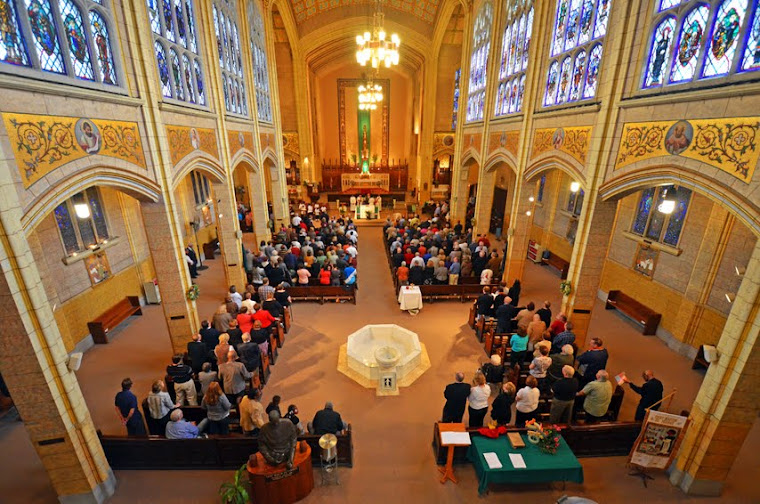Memories fill church set for a rebirth
Look up to the right, above the St. Joseph altar, at the painting of St. William. The face is that of Monsignor William Long.
Look under the metal plate in the second stair of the majestic, pre-Vatican II main altar, and see the keyboard on which the altar boys would sound a sequence of chimes at the holiest parts of the mass.
Go outside, across Leamington Avenue, to the parking lot where signboards used to stand. Look back up at the church building, up at the steeple, the highest point in Chicago's Austin neighborhood -- where, one noon, the Angelus was sung by Elvis Presley.
Come with me to St. Thomas Aquinas Church, once the center of a large, vibrant Roman Catholic parish, my parish for the first 19 years of my life -- but now closed.
It was named after the 13th Century Dominican friar whose wealth of writings earned him the reputation as "the" Christian philosopher and theologian of the Middle Ages.
The story of the church, which stands 12 stories tall at the northeast corner of Leamington Avenue and Washington Boulevard, is one with many echoes throughout the archdiocese. This year alone, Cardinal Joseph Bernardin ordered 28 parishes to close, and at least three more will be eliminated in 1991. The reason: low church attendance and large financial problems.
The story of St. Thomas Aquinas, however, has a different ending.
The church, which opened in December, 1924, was closed in December 1988 following the consolidation of the parish with two others, Resurrection at 5072 W. Jackson Blvd. and St. Mel-Holy Ghost at 4301 W. Washington Blvd.
All three, for more than a half century, had served communities that were predominately Irish and entirely white. In the 1960s, though, a great migration of blacks took place across Chicago's West Side, and nearly all of the whites in the three parishes moved away -- flight that was fueled by panic-peddlers, prejudice and fear.
There were fewer African-American Catholics to fill the pews, and, finally, at the urging of Bernardin, the three parishes joined together as one, under the name of St. Martin De Porres, a 17th Century Peruvian black who ministered to the poor.
The new parish decided to use the St. Mel-Holy Ghost church for its Sunday masses and the Resurrection church for its weekday services. But that was only temporary. They wanted a new church -- estimated cost: $1 million -- and they asked Bernardin for financial help.
To their chagrin, Bernardin said the archdiocese didn't have enough money for that. But he said it could help pay for a renovation of the one church of the three that was in the best shape: St. Thomas Aquinas.
So, the church, which has stood empty except for occasional use by the still-vigorous parish school next door, is facing a resurrection that could come as early as next December.
Yet, the church was never really empty. Too many thousands of people spent too much of their lives -- and too many important moments of their lives -- in this building. As long as it stands, it will be filled with their footsteps.
Come on inside. It's cold now in the pews with the heat turned on just enough -- 52 degrees -- to protect the structure from rot. For an old building, especially one out of use for 24 months, there is very little rot. Indeed, it is the lack of change in the building over all the decades that is most striking to those familiar with it.
In this sacred space, I can see the grownups and children coming in to kneel on the dark wood pews or stand in a line outside the confessionals -- the children whispering and giggling together -- on a Saturday afternoon in spring. I can see the black gospel choir warming up at the small organ in the right wing of the church, just in front of the Statue of St. Thomas Aquinas. I can hear the altar boys -- myself, my brothers, my friends -- kneeling at the foot of the altar as the start of the old Latin mass, rushing through the first of the responses, "Ad Deum qui laetificat juventutem meam."
Next year's renovation won't be the church's first. In the early 1950s, Long, then pastor, oversaw a major facelift. As a thank-you perhaps, an artist involved in the project painted Long into the decoration, putting his face on St. William [see image below] and his head on a major red-cassocked figure, just below St. Thomas Aquinas, in the 50-foot tapestry that looms behind the church's altar.
There is no painting of Elvis, but his moment at St. Thomas Aquinas remains vivid in the minds of those who heard it.
This is how it happened: Each noon, bells from the church would ring to signal the Angelus, a mid-day prayer. St. Thomas Aquinas Church didn't have bells, but used a record.
One day, someone -- an altar boy, it is supposed -- snuck into the church and replaced the record. That noon, instead of solemn bells tolling, the sound that parish members, such as my mother, heard coming out of the loudspeakers at the top of the church steeple was "You Ain't Nothin' but a Hounddog."
Chicago Tribune, December 28, 1990, pages 1 and 7.

No comments:
Post a Comment